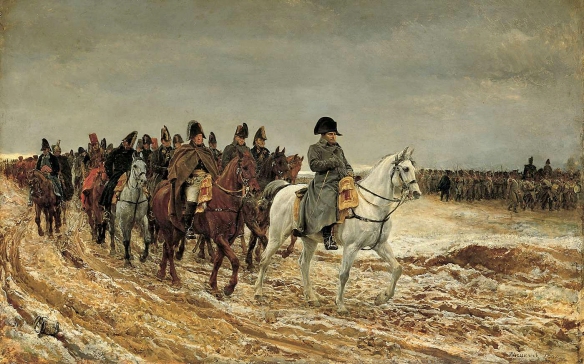
1814 Campagne de France. Jean-Louis-Ernest MEISSONIER, Musée d’Orsay.
The third action of the Six Days campaign in eastern France, the Battle of Chateau-Thierry, resulted in a victory for Napoleon’s troops over the Prussians and Russians under generals Johann Graf Yorck von Wartenburg and Dmitry Osten-Sacken, respectively, as well as the continuation of French momentum against the Allied forces. Two days earlier, Yorck had captured Chateau-Thierry, and after the Allied defeat in the battles of Champaubert (10 February) and Montmirail (11 February), his forces had returned northward to Chateau-Thierry in their retreat. At the onset of the Six Days campaign, Napoleon had ordered Marshal Macdonald to pursue Yorck and recapture the city (to prevent an Allied retreat across the Marne), but Macdonald was unable to reach Chateau-Thierry before the Allies could cross the river and fortify themselves, much to Napoleon’s disappointment.
Napoleon himself and the majority of his troops, together with Mortier, pursued the retreating Allied forces from the battlefield at Montmirail to Chateau-Thierry, leaving Marshal Marmont in reserve at Vertus. He hoped to knock the forces of Yorck and Sacken out of the campaign before turning to confront Field Marshal Gebhard von Blücher leading the Army of Silesia (Russians and Prussians) and Feldmarschall Karl Fürst zu Schwarzenberg of the Army of Bohemia (mostly Austrians).
In the headlong flight to Chateau-Thierry, a French corps under Marshal Ney caught up with Yorck’s rear guard, broke the Allied cavalry line, captured a great deal of baggage, nine pieces of artillery, and two Russian infantry regiments on the Allied right. In the process the French also seized the hills overlooking the Marne. Although the Prussian infantry made a stand at Chateau-Thierry, it served little purpose save that of protecting their retreat across the Marne. The Allies lost some 3,000 troops (approximately 1,250 Prussians and 1,500 Russians) and the guns and baggage captured at the outset of the action, as well as their strategic position in the village, while the French lost only around 600 men.
Owing to lack of a pontoon train, Napoleon remained in Chateau-Thierry the evening of the battle while engineers repaired the bridge over the Marne. It was a mixed victory for Napoleon, however. He had won the day, but the surviving Allied troops escaped across the Marne beyond the river Ourcq, destroying the bridge behind them, and were poised to regroup. He left Marshal Mortier to continue the pursuit of Yorck and Osten-Sacken and planned to face the emerging threat from Schwarzenberg near the Seine. First, however, he decided to confront Blücher yet again, at Vauchamps.
The Battle of Chateau-Thierry highlighted the paradox of Napoleon’s efforts: He could win engagements with daring tactics and seasoned troops, but the discrepancy in numbers was beginning to tell, and soon there would be too many Allied forces to face. By the end of March the Allied troops had reached Paris.
References and further reading Chandler, David G. 1995. The Campaigns of Napoleon. London: Weidenfeld and Nicolson. Delderfield, R. F. 1968. Imperial Sunset: The Fall of Napoleon, 1813-14. Philadelphia: Chilton. Lawford, James. 1977. Napoleon: The Last Campaigns, 1813-1815. London: Roxby. Petre, F. Loraine. 1977. Napoleon at Bay: 1814. London: Arms and Armour.